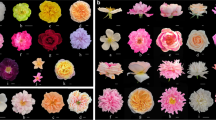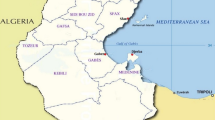Abstract
The immature fruits of domesticated Luffa acutangula (L.) Roxb. are a common vegetable in Asia and India. To learn more about traditional cultivars, accessions were collected from southern Yunnan Province of China, northern Laos, and southeastern Nepal, and assessed for various parameters of genetic diversity. The size and shape of the fruits and seeds varied considerably. A form that we found cultivated only in Nepal bore clusters of small fruits that are produced by hermaphrodite flowers. Plants produced male flowers first, and the first node to bear flowers varied from the second to the twenty-seventh. Twenty-nine allozyme loci were assayed. Within L. acutangula one allozyme locus was polymorphic. Luffa acutangula andL. aegyptiaca are fixed for different alleles at nine loci, indicating that they are completely reproductively isolated from each other.
Similar content being viewed by others
Literature Cited
Burkill, H. M. 1985. The useful plants of West Tropical Africa. Edition 2. Royal Botanical Gardens, Kew. The Whitefriars Press Limited, London, England.
Burkill, I. H. 1935. A dictionary of the economic products of the Malay Peninsula, Volume I. Crown Agents for the Colonies, London, England.
Chakravarty, H. H. 1990. Cucurbits in India and their role in development of vegetable crops. Pages 325–348 in D. M. Bates, R. W. Robinson, and C. Jeffrey, eds., Biology and utilization of the Cucurbitaceae. Cornell University Press, Ithaca, New York.
Chung, S. M., D. S. Decker-Walters, andJ. E. Staub. 2003. Genetic relationships within the Cucurbitaceae as assessed by consensus chloroplast simple sequence repeats (ccSSR) marker and sequence analyses. Canadian Journal of Botany 81: 814–832.
DeCandolle, A. 1959. Origin of cultivated plants. (Reprint of the second edition, 1886). Hafner Publishing Co., New York.
Doebley, J. 1989. Isozyme evidence and the evolution of crop plants. Pages 165–191 in D. E. Soltis and P. S. Soltis, eds., Isozymes in plant biology. Dioscorides Press, Portland, OR.
Heiser, C. B., andE. E. Schilling. 1988. Phylogeny and distribution ofLuffa (Cucurbitaceae). Biotropica 20:185–191.
—, andE. E. Schilling. 1990. The genusLuffa: A problem in phytogeography. Pages 120–133 in D. M. Bates, R. W. Robinson, and C. Jeffrey, eds., Biology and utilization of the Cucurbitaceae. Cornell University Press, Ithaca, NY.
Herbert, P. D. N., andM. J. Beaton. 1993. Methodologies for allozyme analysis using cellulose acetate electrophoresis: A practical handbook. Helena Laboratories, Beaumont, TX.
Jansen, G. J., B. H. Gildemacher, andL. Phuphathanaphong. 1993.Luffa P. Miller. Pages 194–197 in J. S. Siemonsma and K. Piluek, eds., Plant resources of South-East Asia. No. 8. Vegetables. Pudoc Scientific Publishers. Wageningen, The Netherlands.
Joshi, P. 1995. Ethnobotany of the primitive tribes in Rajasthan. Rupa Offset Printers, Jaipur, India.
Keraudren-Aymonin, M. 1975. Cucurbitacées. Pages 3–110 in A. Aubréville and J.-F. Leroy, eds., Flore du Cambodge Laos et du Viêt-Nam. Muséum National D’Histoire Naturelle, Paris, France.
Marr, K.L., Y.-M. Xia, andN. K. Bhattarai. 2004. Allozyme, morphological, and nutritional analysis bearing on the domestication ofMomordica charantia L. (Cucurbitaceae). Economie Botany 58: 435–455.
—, —, and — 2005. Allozymic, morphological, linguistic, plant use, and nutritional data on wild and cultivatedLuffa aegyptiaca L. (Cucurbitaceae) from Nepal, southern China, and northern Laos. Economic Botany 59:137–153.
Nazimuddin, S., andS. S. H. Naqvi. 1984. No. 154, Cucurbitaceae. Pages 1–56 in E. Nasir and D. I. Ali, eds., Flora of Pakistan. Department of Botany, Karachi, Pakistan.
Negi, K. S., andK. C. Pant. 1994. Genetic wealth of agri-horticultural crops, their wild relatives, indigenous medicinal and aromatic plants of U.P. Himalaya. Journal of Economic and Taxonomic Botany 18:17–41.
Nei, M. 1978. Estimation of average heterozygosity and genetic distance from a small number of individuals. Genetics 89:583–590.
Neuwinger, H. D. 1994. African ethnobotany: Poisons and drugs. Chapman and Hall, London, England.
Pasha, M. K., andS. P. Sen. 1991. Seed protein patterns of Cucurbitaceae and their taxonomic implications. Biochemical Systematics and Ecology 19:569–576.
Prain, D. 1903. Bengal plants: A list of the phanerogams, ferns and fern-allies indigenous to, or commonly cultivated in, the Lower Provinces and Chittagong, with definitions of the natural orders and genera, and keys to the genera and species. West, Newman and Co., London, England.
Roy, R. P., andS. Saran. 1990. Sex expression in the Cucurbitaceae. Pages 251–268 in D. M. Bates, R. W. Robinson, and C. Jeffrey, eds., Biology and utilization of the Cucurbitaceae. Cornell University Press, Ithaca, NY.
Samvatsar, S., andV.B. Diwanji. 2000. Plant sources for the treatment of jaundice in the tribals of Western Madhya Pradesh of India. Journal of Ethnopharmacology 73:313–316.
Sinnot, E. W., andR. Bloch. 1943. Luffa sponges, a new crop for the Americas. Journal of the New York Botanical Garden 44:125–134.
Swofford, D. L., andR. B. Selander. 1989. BIOSYS-1: A computer program for the analysis of allelic variation in population genetics and biochemical systematics (Release 1.7). Natural History Survey, Champaign, IL.
Yang, S. L., andT. W. Walters. 1992. Ethnobotany and the economic role of the Cucurbitaceae in China. Economic Botany 46:349–367.
Zeven, A. C., andP. M. Zhukovsky. 1975. Dictionary of cultivated plants and their centres of diversity. Center from Agricultural Publishing and Documentation, Wageningen, The Netherlands.
Author information
Authors and Affiliations
Corresponding author
Rights and permissions
About this article
Cite this article
Marr, K.L., Bhattarai, N.K. & Xia, YM. Allozymic, morphological, and phenological diversity in cultivatedLuffa acutangula (Cucurbitaceae) from China, Laos, and Nepal, and Allozyme Divergence betweenL. acutangula andL. Aegyptiaca . Econ Bot 59, 154–165 (2005). https://doi.org/10.1663/0013-0001(2005)059[0154:AMAPDI]2.0.CO;2
Received:
Accepted:
Issue Date:
DOI: https://doi.org/10.1663/0013-0001(2005)059[0154:AMAPDI]2.0.CO;2




